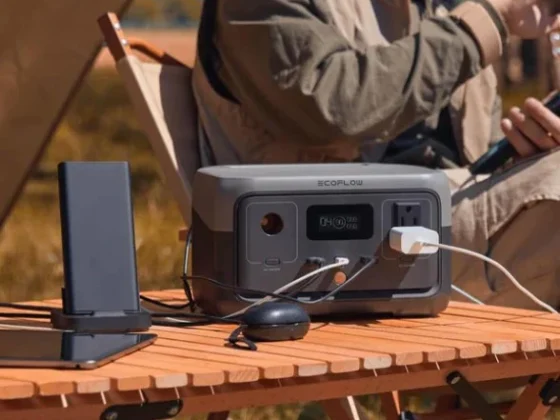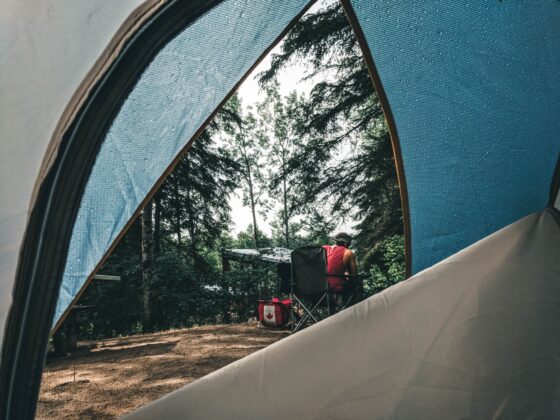Whether heading to the great outdoors for a weekend getaway or embarking on a long trek, a portable power station can be a game-changer. In this comprehensive guide, we’ll walk you through everything you need to know to make the right choice. We’ll cover everything from power capacity and battery life to size and weight considerations. Our expert tips and insights will ensure you find the perfect portable power station that suits your needs and keeps you powered up during outdoor adventures.
But it doesn’t end there. We’ll also share the top recommended products on the market, all backed by customer reviews and ratings. Whether you’re an experienced camper or a novice adventurer, our guide will equip you with the knowledge to make an informed decision. Don’t let power outages ruin your camping experience – get ready to find the perfect portable power station and stay connected wherever you go.
Benefits of using a portable power station while camping
A portable power station becomes a lifeline when you’re out in the wilderness, far away from power outlets. Here are some key benefits of using a portable power station while camping:
- Powering essential devices: Whether charging your smartphone to stay connected or running a mini-fridge to keep your food fresh, a portable power station can power all your essential devices. With multiple AC outlets, USB ports, and DC outputs, you’ll have the flexibility to charge various devices simultaneously.
- Convenience and portability: Portable power stations are compact and lightweight compared to traditional generators. They are designed for easy transportation and can fit in your car trunk or backpack. No more lugging around heavy equipment or dealing with messy fuel.
- Quiet and eco-friendly: Portable power stations are powered by lithium-ion or lead-acid batteries, which means they operate silently and produce zero emissions. You can enjoy the peace and tranquility of nature without disturbing the environment or your fellow campers.
- Emergency backup power: In case of a sudden power outage or emergency situation, a portable power station can provide a reliable backup power source. Knowing that you have a backup plan, especially during extreme weather conditions or remote camping locations, gives you peace of mind.
- Versatility: A portable power station is not just for camping. It can also come in handy during outdoor events, road trips, RV adventures, and even as a backup power source at home. It’s a versatile investment that offers long-term value beyond your camping trips.
Considering these benefits, it’s clear that a portable power station is a must-have for any camping enthusiast. Now, let’s dive into the factors you must consider when choosing the right portable power station.
Factors to consider when choosing a portable power station
Choosing the right portable power station can be overwhelming, with myriad options. To help you make an informed decision, here are some key factors to consider:
- Power capacity and output: The power capacity of a portable power station determines how many devices it can charge and for how long. It is usually measured in watt-hours (Wh) or ampere-hours (Ah). Consider your power requirements and the devices you charge to determine your ideal power capacity. Additionally, check the power output options such as AC outlets, USB ports, and DC outputs to ensure device compatibility.
- Battery type and life: Portable power stations are commonly equipped with either lithium-ion or lead-acid batteries. Lithium-ion batteries offer higher energy density, longer lifespan, and lighter weight than lead-acid batteries. However, lead-acid batteries are generally more affordable. Consider your budget and the trade-offs between battery types when making your decision. Additionally, check the battery life and charging time to ensure it meets your camping needs.
- Size and weight: Portability is crucial in camping equipment. Consider the size and weight of the portable power station to ensure it is suitable for your camping setup. If you’re backpacking or hiking, you’ll want a lightweight and compact option. However, if you’re camping with a vehicle, you can opt for a larger and heavier model.
- Durability and ruggedness: Camping involves exposure to various weather conditions and rough handling. Look for a portable power station built to withstand outdoor elements such as dust, water, and impact. Check for rugged construction, protective features, and IP ratings to ensure the durability of the device.
- Safety features: Safety should be a top priority when choosing a portable power station. Look for features like surge protection, short circuit protection, temperature control, and overcharge/over-discharge protection. These features protect your devices and ensure the safety of the Nitecore power station itself, for instance.
Considering these factors, you can narrow your options and find a portable power station that meets your camping requirements. Now, let’s take a closer look at each factor to help you make an informed decision.
Understanding power capacity and output
A portable power station’s power capacity and output are crucial factors to consider when purchasing. Let’s dive deeper into these aspects:
- Power capacity: The power capacity of a portable power station is measured in watt-hours (Wh) or ampere-hours (Ah). It indicates how much energy the battery can store and deliver. The higher the power capacity, the more devices you can charge and the longer the runtime. Consider your power requirements and the devices you charge to determine your ideal power capacity. Remember that devices like smartphones and tablets have lower power requirements than appliances like mini-fridges or electric stoves.
- Power output options: Portable power stations come with various power output options, such as AC outlets, USB ports, and DC outputs. AC outlets are essential for charging devices that require a standard wall outlet, such as laptops or electric coolers. USB ports conveniently charge smartphones, tablets, or other USB-powered devices. DC outputs, usually in the form of car cigarette lighter sockets, are ideal for powering or charging devices that run on DC power, such as car refrigerators or air compressors. Ensure that the power station has the right combination of power output options to meet your device charging needs.
Understanding a portable power station’s power capacity and output will help you determine if it can meet your camping requirements. Now, let’s move on to the next factor – picking the right size and weight for your camping needs.
Determining the right size and weight for your camping needs
The size and weight of a portable power station play a crucial role in its portability and convenience during camping. Here’s what you need to consider:
- Camping style: Consider your camping style and setup to determine the ideal size and weight of the portable power station. If you’re backpacking or hiking, you’ll want a lightweight and compact option that can easily fit in your backpack without adding excessive weight. On the other hand, if you’re camping with a vehicle, you have more flexibility in choosing a larger and heavier model.
- Power requirements: Assess your power requirements and the devices you’ll charge during your camping trips. If you’re planning to power multiple devices simultaneously or run high-power appliances like electric grills or portable heaters, you’ll need a portable power station with a higher power capacity. This may result in a larger and heavier device.
- Portability vs. power: There’s often a trade-off between portability and power capacity. Smaller and lighter portable power stations may have lower power capacities. In contrast, larger and heavier ones can offer more power but are less portable. Strike a balance between your power needs and the portable size and weight that suits your camping style.
Consider these factors when determining the right size and weight of the portable power station for your camping needs. Now, let’s explore the essential features and accessories to look for.
Looking for essential features and accessories
Certain features and accessories can enhance your camping experience when choosing a portable power station. Here are some essential ones to look for:
- Multiple charging options: Look for a portable power station with various charging options, such as AC outlets, USB ports, and DC outputs. This allows you to charge different devices simultaneously, ensuring compatibility with your camping gear.
- LCD display: An LCD display provides real-time information about the battery level, power consumption, and remaining runtime. It allows you to monitor and manage the power usage effectively.
- Built-in inverter: An inverter converts the DC power stored in the battery into AC power, which is essential for charging devices that require a standard wall outlet. Ensure the portable power station has a built-in inverter for AC power compatibility.
- Expandability: Some portable power stations offer expandable options, allowing you to add extra battery modules or solar panels for increased power capacity and charging options. If you anticipate needing more power or want to use renewable energy sources, consider a portable power station with expandability features.
- Fast charging: Look for a portable power station with fast charging technology. This allows you to recharge the battery quickly, so you spend less time waiting and more time enjoying your camping adventures.
In addition to these features, certain accessories can enhance the functionality and convenience of your EcoFlow power station, for instance. These include solar panels for recharging in remote locations, car chargers for charging on the go and carrying cases for easy transportation. Consider your specific needs and look for a portable power station with the necessary features and accessories to enhance your camping experience.
Now that we’ve covered the essential features and accessories, let’s compare different types of portable power stations – lithium-ion vs. lead-acid.
Comparing different types of portable power stations – lithium-ion vs. lead-acid
Portable power stations are commonly equipped with either lithium-ion or lead-acid batteries. Let’s compare these two types:
- Lithium-ion batteries: Lithium-ion batteries are the most common type found in portable power stations due to their high energy density, lightweight, and long lifespan. They provide more power in a smaller, lighter package, making them ideal for portable applications. Lithium-ion batteries also have a lower self-discharge rate, meaning they can hold their charge for longer periods, making them suitable for occasional use. However, they are generally more expensive than lead-acid batteries.
- Lead-acid batteries: Lead-acid batteries have been used for a long time and are known for their reliability and affordability. They are bulkier and heavier than lithium-ion batteries, making them less suitable for backpacking or hiking. Lead-acid batteries also have a higher self-discharge rate, meaning they must be recharged more frequently. However, they are more cost-effective and can provide a sufficient power supply for camping needs.
When choosing between lithium-ion and lead-acid batteries, consider your budget, weight requirements, and power needs. Lithium-ion batteries are the way to go if you prioritize lightweight and long-lasting power. However, if cost-effectiveness and reliability are more critical, lead-acid batteries are viable.
Now that we’ve covered the battery types, let’s explore the top brands and models of portable power stations for camping.
Tips for maintaining and maximizing the lifespan of your portable power station
To ensure the longevity and optimal performance of your portable power station, follow these maintenance tips:
- Keep it dry and clean: Portable power stations are not waterproof, so keeping them dry and protected from moisture is crucial. Avoid exposing them to rain, snow, or excessive humidity. Clean the exterior regularly to remove dirt or dust buildup.
- Store it properly: Store the portable power station in a cool and dry place when not in use. Avoid extreme temperatures and direct sunlight, as they can affect the battery life and performance.
- Charge and discharge regularly: Lithium-ion batteries benefit from regular charging and discharging cycles. It’s recommended to recharge the battery every 3-6 months, even if it’s not in use. This helps maintain the battery capacity and prevents degradation over time.
- Avoid overcharging and over-discharging: Overcharging or over-discharging the battery can shorten its lifespan. Follow the manufacturer’s recommendations for charging and discharging levels to avoid any damage to the battery.
- Use compatible chargers: Always use the provided charger or a compatible charger recommended by the manufacturer. Using incompatible chargers can lead to improper charging, overheating, or reduced battery life.
- Avoid excessive heat: Exposure to high temperatures can damage the battery and affect its performance. Avoid leaving the portable power station in direct sunlight.
In conclusion, choosing the right portable power station for camping is essential to ensure a comfortable and convenient outdoor experience. By considering factors such as power capacity, portability, battery type, and additional features, campers can make an informed decision that suits their specific needs. Whether charging electronic devices, powering appliances, or running essential equipment, a reliable portable power station is a must-have for any camping trip.
With the ultimate guide provided, campers can confidently navigate the market and select a power station that will provide them with the necessary power to enjoy the great outdoors without sacrificing modern conveniences. So, get ready to embark on your next camping adventure with a trusted portable power station by your side!



